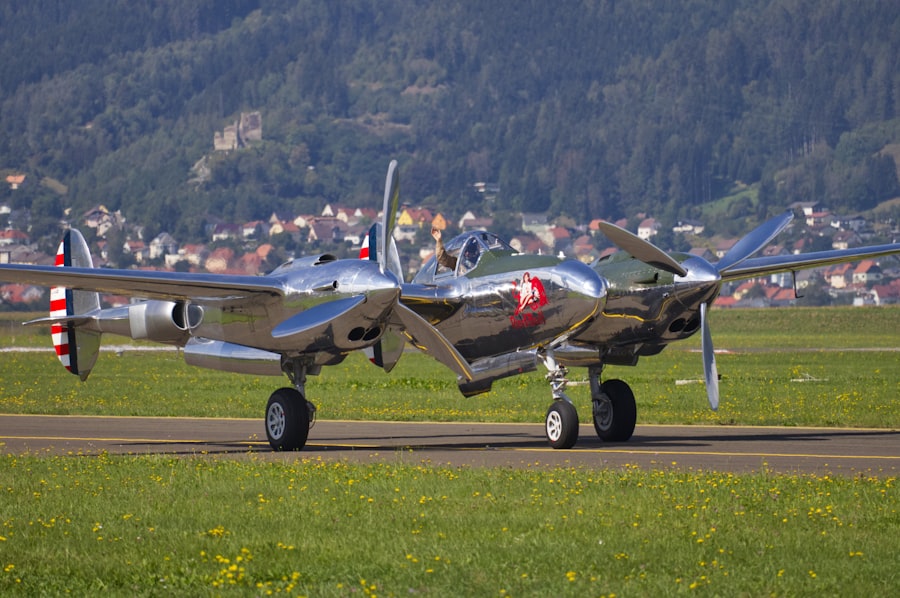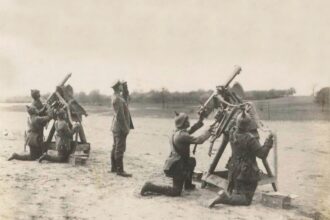The Junkers Jumo 004 stands as a pivotal milestone in the annals of aviation history, representing the dawn of the jet age. Developed in Germany during World War II, this turbojet engine was the first to be mass-produced and utilized in a military aircraft, specifically the Messerschmitt Me 262. Its introduction marked a significant shift in aerial combat, as it provided unprecedented speed and performance compared to traditional piston-engine fighters.
The Jumo 004 not only transformed the dynamics of warfare but also laid the groundwork for future advancements in jet propulsion technology. As the first operational turbojet engine, the Jumo 004’s design and engineering innovations were groundbreaking for their time. It encapsulated the spirit of rapid technological advancement that characterized the era, driven by the urgent demands of war.
The engine’s development was a response to the need for faster, more agile aircraft capable of outmaneuvering enemy fighters. The legacy of the Jumo 004 extends beyond its immediate impact on World War II; it has influenced generations of jet engines and remains a subject of fascination for aviation enthusiasts and historians alike.
Key Takeaways
- The Junkers Jumo 004 was the world’s first mass-produced turbojet engine, revolutionizing aviation technology.
- The development of the Jumo 004 engine was a result of innovative engineering and the need for faster, more powerful aircraft during World War II.
- With a thrust of 2,000 pounds, the Jumo 004 engine played a crucial role in powering the German Messerschmitt Me 262, the world’s first operational jet-powered fighter aircraft.
- Designing the Jumo 004 presented challenges in materials, cooling, and combustion, leading to innovations that would shape the future of jet engine technology.
- The legacy of the Jumo 004 continues to influence modern aviation, with its impact on jet engine development and its significance in preserving aviation history through restoration and preservation efforts.
The Development and History of the Jumo 004 Engine
The journey of the Jumo 004 began in the early 1930s when German engineers recognized the potential of jet propulsion.
The initial designs faced numerous challenges, including issues related to materials and aerodynamics.
However, with relentless experimentation and refinement, the Jumo 004 began to take shape. By 1941, the first prototypes of the Jumo 004 were tested, showcasing promising results that caught the attention of military officials. The engine’s design featured a centrifugal compressor and a simple layout that allowed for easier manufacturing.
As World War II escalated, the urgency to produce effective jet fighters intensified, leading to increased investment in the Jumo 004 project. By 1944, it was in full-scale production, powering not only the Me 262 but also other aircraft designs that sought to capitalize on its revolutionary capabilities.
The Technical Specifications of the Jumo 004

The technical specifications of the Jumo 004 reveal its innovative design and engineering prowess. The engine operated on a single-spool turbojet configuration, featuring a centrifugal compressor that compressed incoming air before it entered the combustion chamber. This design allowed for a maximum thrust output of approximately 1,800 pounds, which was remarkable for its time.
The engine’s dimensions were compact, with a length of about 3.5 meters and a diameter of around 1 meter, making it suitable for integration into various aircraft designs. One notable aspect of the Jumo 004 was its use of a unique fuel system that relied on a mixture of aviation gasoline and kerosene. This combination provided the necessary energy for combustion while ensuring efficient operation at high speeds.
Additionally, the engine’s operational ceiling reached altitudes of up to 12,000 meters, allowing aircraft equipped with the Jumo 004 to engage in high-altitude combat effectively. Despite its groundbreaking features, the engine was not without its drawbacks, including reliability issues and a relatively short operational lifespan.
The Role of the Jumo 004 in World War II
| Aspect | Details |
|---|---|
| Manufacturer | Junkers Motoren |
| Role | Jet engine for aircraft |
| First flight | 1942 |
| Used by | Luftwaffe (German Air Force) |
| Significance | First mass-produced jet engine in history |
The Jumo 004 played a crucial role in altering the course of aerial warfare during World War
As Germany sought to regain air superiority against Allied forces, the introduction of jet-powered aircraft equipped with the Jumo 004 provided a significant advantage. The Messerschmitt Me 262, powered by this engine, became one of the most formidable fighters of its time, capable of reaching speeds exceeding 540 miles per hour. This speed allowed it to intercept Allied bombers effectively and engage enemy fighters with unprecedented agility.
However, despite its impressive capabilities, the impact of the Jumo 004 was somewhat limited by production challenges and strategic miscalculations. The late introduction of jet technology into the war meant that its full potential was never realized on a large scale. Additionally, issues such as fuel shortages and mechanical failures hampered operational effectiveness.
Nevertheless, the Jumo 004’s presence on the battlefield marked a turning point in aviation history, demonstrating the viability of jet propulsion in military applications.
Challenges and Innovations in Designing the Jumo 004

Designing the Jumo 004 was fraught with challenges that required innovative solutions from its engineers. One significant hurdle was achieving reliable performance under extreme conditions. The high temperatures generated during operation posed risks to engine components, necessitating advancements in materials science.
Engineers experimented with various alloys and heat-resistant materials to enhance durability and performance. Another challenge lay in optimizing fuel efficiency while maintaining thrust output. The team at Junkers had to balance these competing demands to ensure that aircraft could operate effectively without excessive fuel consumption.
This led to innovations in combustion chamber design and airflow management within the engine. Ultimately, these challenges spurred advancements that would influence future jet engine designs long after World War II had ended.
The Impact of the Jumo 004 on Aviation Technology
The introduction of the Jumo 004 had far-reaching implications for aviation technology beyond its immediate military applications. As one of the first turbojet engines to enter mass production, it set a precedent for future developments in jet propulsion systems. The engineering principles and design philosophies established during its development laid the groundwork for subsequent generations of jet engines.
Moreover, the Jumo 004’s performance characteristics influenced aircraft design across various sectors, including commercial aviation. Its ability to deliver high speeds and improved maneuverability prompted manufacturers to explore jet propulsion as a viable alternative to piston engines in civilian aircraft. This shift ultimately contributed to the rapid evolution of commercial air travel in the post-war era.
The Legacy of the Jumo 004 in Post-War Aviation
In the years following World War II, the legacy of the Jumo 004 continued to resonate within the aviation industry.
The principles established by Junkers’ design informed new projects aimed at enhancing performance and efficiency in jet engines.
Additionally, several post-war aircraft designs drew inspiration from the Jumo 004’s configuration and operational characteristics. Countries such as Britain and France developed their own turbojet engines that incorporated lessons learned from German engineering practices during the war. This cross-pollination of ideas ultimately accelerated advancements in aviation technology globally.
The Influence of the Jumo 004 on Jet Engine Development
The influence of the Jumo 004 on jet engine development cannot be overstated. Its introduction marked a paradigm shift in how engineers approached aircraft propulsion systems. The concepts pioneered by Junkers regarding compressor design, fuel efficiency, and thermal management became foundational elements in subsequent turbojet and turbofan engines.
Furthermore, as aviation technology progressed into the late 20th century, many modern jet engines can trace their lineage back to innovations introduced with the Jumo 004. The emphasis on reliability and performance established by this early turbojet engine set standards that continue to guide engineers today as they strive for greater efficiency and power in modern aviation.
The Jumo 004 in Modern Aviation
While it may seem distant from contemporary aviation practices, remnants of the Jumo 004’s influence can still be observed today. Modern jet engines have evolved significantly since its inception; however, many fundamental principles remain intact. Engineers continue to build upon concepts related to airflow dynamics and combustion efficiency that were first explored during the development of this historic engine.
Moreover, as aviation technology continues to advance toward sustainable practices, lessons learned from early turbojet designs like the Jumo 004 are being revisited. Engineers are exploring ways to enhance fuel efficiency while reducing emissions—an endeavor that echoes some of the challenges faced by Junkers’ team decades ago.
Restoring and Preserving the Jumo 004
Efforts to restore and preserve examples of the Jumo 004 have become increasingly important as interest in aviation history grows among enthusiasts and historians alike. Various museums and aviation organizations have undertaken projects aimed at restoring these engines to their former glory for educational purposes and public display. These restoration efforts not only honor the engineering achievements of their time but also serve as tangible reminders of aviation’s evolution.
In addition to physical restoration projects, there is also a growing interest in documenting and archiving information related to the Jumo 004’s design and operational history. This includes collecting technical manuals, photographs, and personal accounts from those who worked on or operated these engines during their service life. Such initiatives ensure that future generations can appreciate and learn from this remarkable chapter in aviation history.
Uncovering the Secrets and Significance of the Jumo 004
The Junkers Jumo 004 stands as a testament to human ingenuity and innovation during one of history’s most tumultuous periods. Its development marked a significant turning point in aviation technology, paving the way for future advancements that would shape both military and civilian aviation for decades to come. Despite its challenges and limitations during World War II, its legacy endures as a symbol of progress in jet propulsion.
As modern aviation continues to evolve, reflecting on historical milestones like the Jumo 004 provides valuable insights into how far technology has come—and where it may lead in the future. By preserving its history and understanding its significance, enthusiasts and historians alike can ensure that this remarkable engine remains an integral part of aviation’s rich narrative for years to come.
The Junkers Jumo 004 was a groundbreaking development in aviation history, being the world’s first mass-produced turbojet engine. Its design and implementation marked a significant leap in aircraft technology during World War II. For those interested in exploring more about the technological advancements of this era, a related article can be found on the website “In The War Room.” This article delves into various aspects of wartime innovations and their impact on modern engineering. You can read more about these fascinating topics by visiting In The War Room.
WATCH THIS! 🪖How Stolen Nazis Built Cold War Power
FAQs
What is the Junkers Jumo 004?
The Junkers Jumo 004 was the world’s first mass-produced turbojet engine used in aircraft. It was developed by the German engineer Anselm Franz in the 1940s and was used in the Messerschmitt Me 262, the world’s first operational jet-powered fighter aircraft.
What were the key features of the Junkers Jumo 004?
The Junkers Jumo 004 was a pioneering turbojet engine that featured an axial-flow compressor, annular combustion chamber, and a single-stage turbine. It was designed to be compact, lightweight, and powerful, with a thrust output of around 2,000 pounds.
What impact did the Junkers Jumo 004 have on aviation?
The Junkers Jumo 004 revolutionized aviation by introducing jet propulsion to military aircraft. Its use in the Messerschmitt Me 262 gave the German Luftwaffe a significant technological advantage during World War II, and its design influenced subsequent jet engine development around the world.
What were some of the challenges in developing the Junkers Jumo 004?
The development of the Junkers Jumo 004 faced challenges such as material shortages, technical limitations, and the need for secrecy due to the wartime conditions in Nazi Germany. Despite these obstacles, the engine successfully entered mass production and played a crucial role in the advancement of jet propulsion technology.
What is the legacy of the Junkers Jumo 004?
The Junkers Jumo 004 left a lasting legacy as a groundbreaking turbojet engine that paved the way for the future of aviation. Its impact on military aircraft design and its influence on subsequent jet engine development solidified its place in the history of aerospace engineering.




